Aviation Accidents and Spatial Disorientation: A Comprehensive Study
VerifiedAdded on 2023/01/23
|7
|1717
|23
Report
AI Summary
This report investigates the critical issue of spatial disorientation (SD) in aviation and its contribution to accidents. It highlights that SD, the body's inability to maintain balance in a three-dimensional environment, is a significant factor, particularly during night flights due to visual illusions and sensory conflicts. The study examines the causes of SD, including pilot errors, and the impact of cockpit lighting and environmental conditions. It emphasizes the importance of pilot training, the reliability of flight instruments, and the development of trust in these instruments as countermeasures. The report also discusses the Federal Aviation Administration's recommendations for pilot behavior during SD episodes. The primary conclusion is that improved pilot training and maintenance of reliable flight instruments are essential to mitigate the risks associated with SD and improve overall aviation safety.
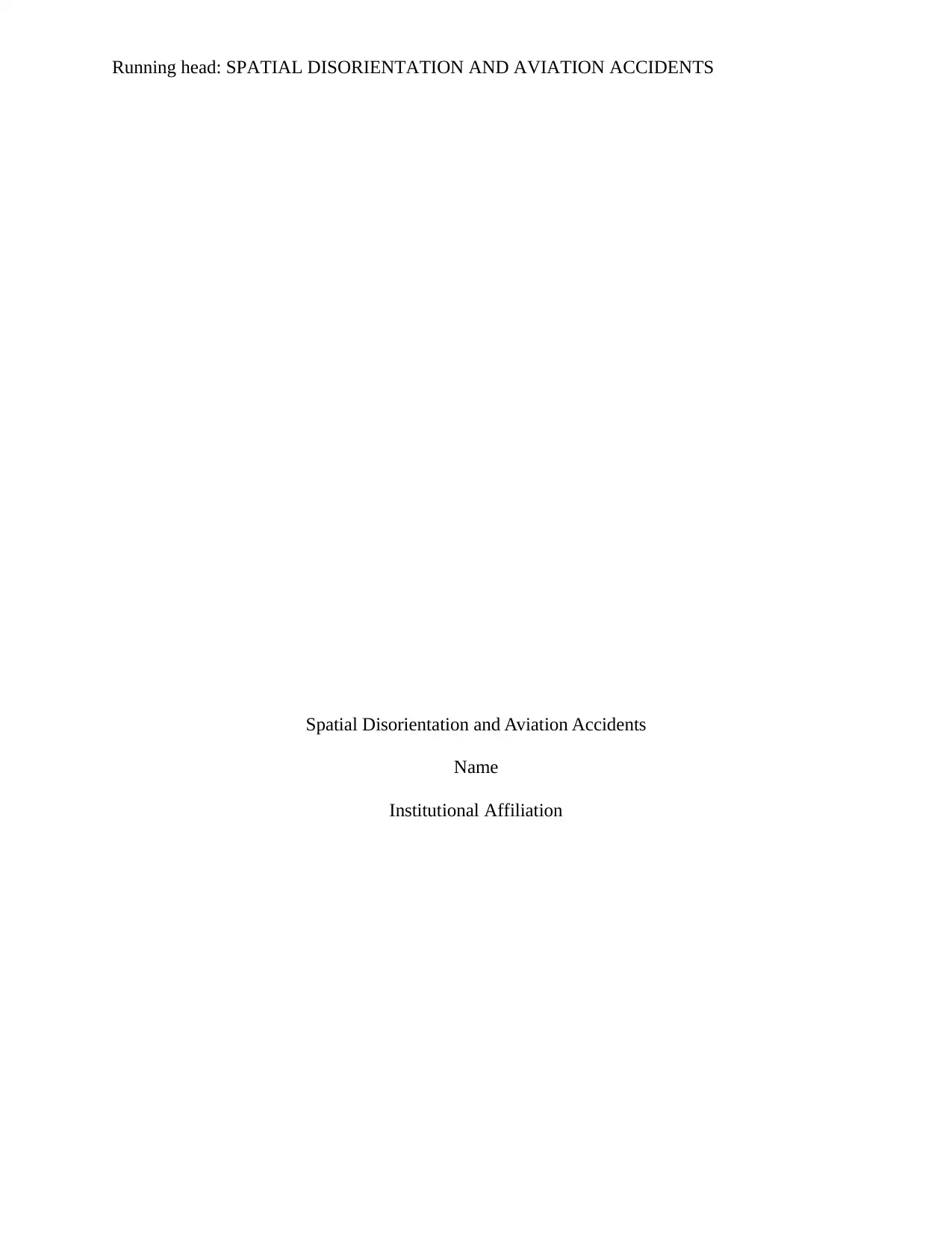
Running head: SPATIAL DISORIENTATION AND AVIATION ACCIDENTS
Spatial Disorientation and Aviation Accidents
Name
Institutional Affiliation
Spatial Disorientation and Aviation Accidents
Name
Institutional Affiliation
Paraphrase This Document
Need a fresh take? Get an instant paraphrase of this document with our AI Paraphraser
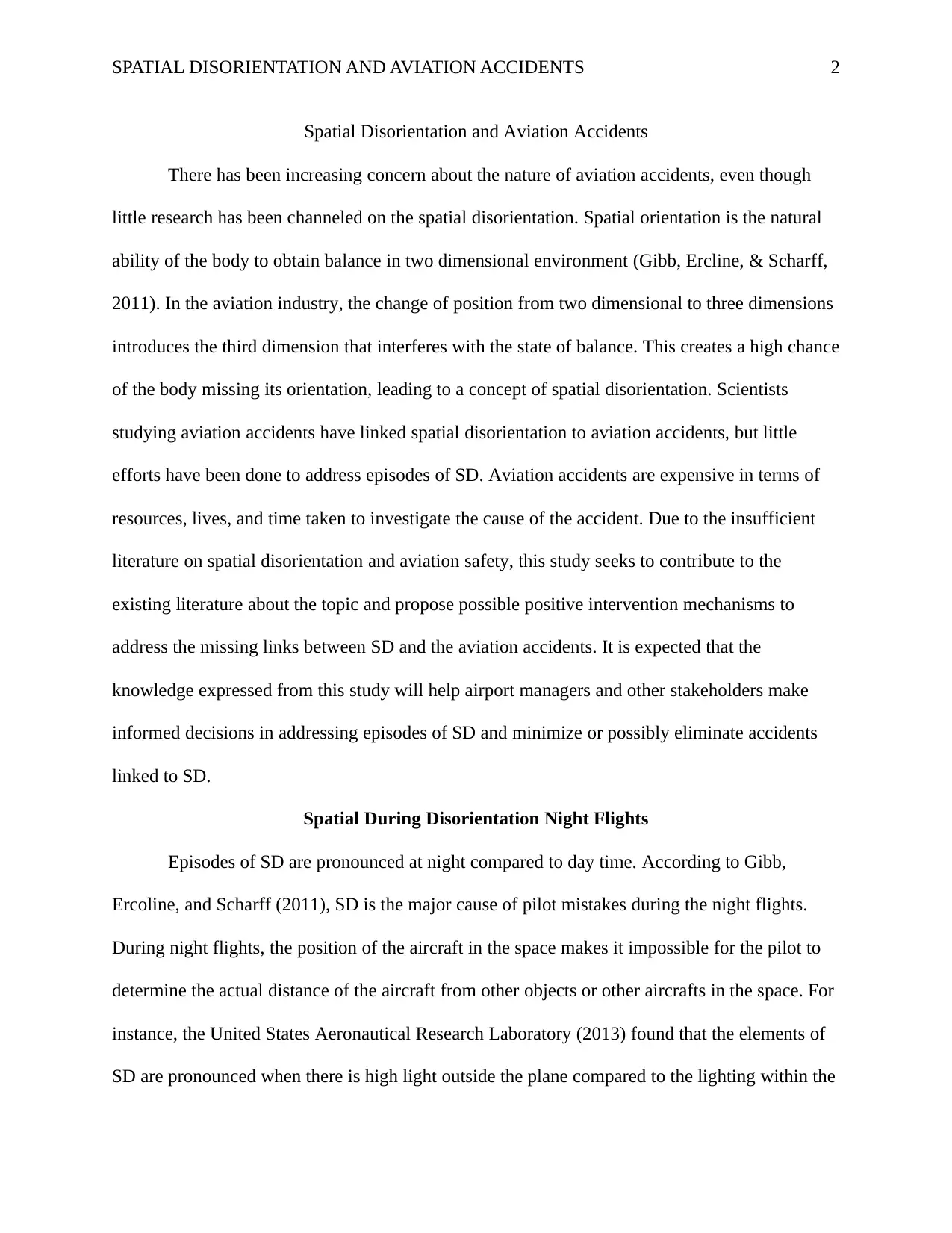
SPATIAL DISORIENTATION AND AVIATION ACCIDENTS 2
Spatial Disorientation and Aviation Accidents
There has been increasing concern about the nature of aviation accidents, even though
little research has been channeled on the spatial disorientation. Spatial orientation is the natural
ability of the body to obtain balance in two dimensional environment (Gibb, Ercline, & Scharff,
2011). In the aviation industry, the change of position from two dimensional to three dimensions
introduces the third dimension that interferes with the state of balance. This creates a high chance
of the body missing its orientation, leading to a concept of spatial disorientation. Scientists
studying aviation accidents have linked spatial disorientation to aviation accidents, but little
efforts have been done to address episodes of SD. Aviation accidents are expensive in terms of
resources, lives, and time taken to investigate the cause of the accident. Due to the insufficient
literature on spatial disorientation and aviation safety, this study seeks to contribute to the
existing literature about the topic and propose possible positive intervention mechanisms to
address the missing links between SD and the aviation accidents. It is expected that the
knowledge expressed from this study will help airport managers and other stakeholders make
informed decisions in addressing episodes of SD and minimize or possibly eliminate accidents
linked to SD.
Spatial During Disorientation Night Flights
Episodes of SD are pronounced at night compared to day time. According to Gibb,
Ercoline, and Scharff (2011), SD is the major cause of pilot mistakes during the night flights.
During night flights, the position of the aircraft in the space makes it impossible for the pilot to
determine the actual distance of the aircraft from other objects or other aircrafts in the space. For
instance, the United States Aeronautical Research Laboratory (2013) found that the elements of
SD are pronounced when there is high light outside the plane compared to the lighting within the
Spatial Disorientation and Aviation Accidents
There has been increasing concern about the nature of aviation accidents, even though
little research has been channeled on the spatial disorientation. Spatial orientation is the natural
ability of the body to obtain balance in two dimensional environment (Gibb, Ercline, & Scharff,
2011). In the aviation industry, the change of position from two dimensional to three dimensions
introduces the third dimension that interferes with the state of balance. This creates a high chance
of the body missing its orientation, leading to a concept of spatial disorientation. Scientists
studying aviation accidents have linked spatial disorientation to aviation accidents, but little
efforts have been done to address episodes of SD. Aviation accidents are expensive in terms of
resources, lives, and time taken to investigate the cause of the accident. Due to the insufficient
literature on spatial disorientation and aviation safety, this study seeks to contribute to the
existing literature about the topic and propose possible positive intervention mechanisms to
address the missing links between SD and the aviation accidents. It is expected that the
knowledge expressed from this study will help airport managers and other stakeholders make
informed decisions in addressing episodes of SD and minimize or possibly eliminate accidents
linked to SD.
Spatial During Disorientation Night Flights
Episodes of SD are pronounced at night compared to day time. According to Gibb,
Ercoline, and Scharff (2011), SD is the major cause of pilot mistakes during the night flights.
During night flights, the position of the aircraft in the space makes it impossible for the pilot to
determine the actual distance of the aircraft from other objects or other aircrafts in the space. For
instance, the United States Aeronautical Research Laboratory (2013) found that the elements of
SD are pronounced when there is high light outside the plane compared to the lighting within the
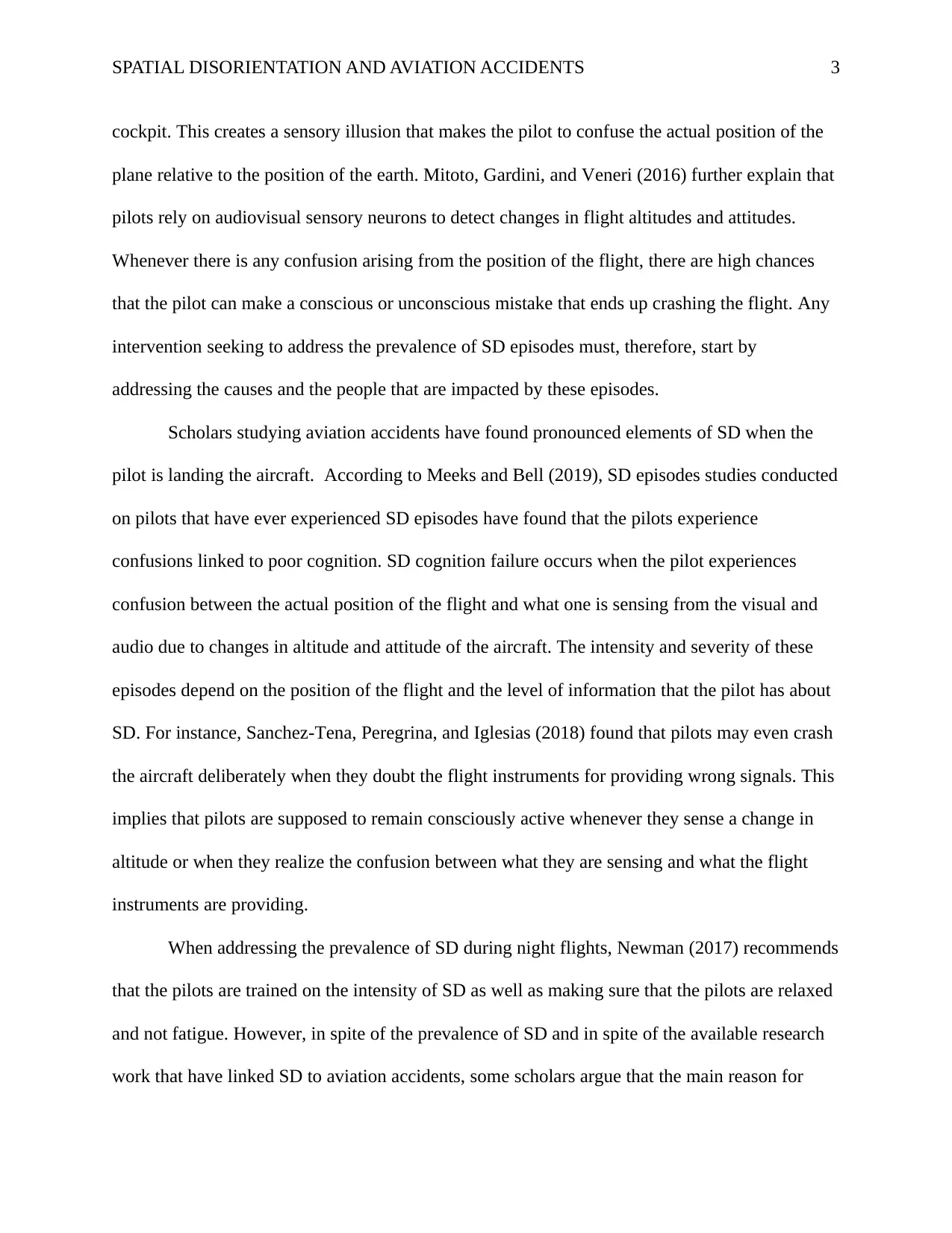
SPATIAL DISORIENTATION AND AVIATION ACCIDENTS 3
cockpit. This creates a sensory illusion that makes the pilot to confuse the actual position of the
plane relative to the position of the earth. Mitoto, Gardini, and Veneri (2016) further explain that
pilots rely on audiovisual sensory neurons to detect changes in flight altitudes and attitudes.
Whenever there is any confusion arising from the position of the flight, there are high chances
that the pilot can make a conscious or unconscious mistake that ends up crashing the flight. Any
intervention seeking to address the prevalence of SD episodes must, therefore, start by
addressing the causes and the people that are impacted by these episodes.
Scholars studying aviation accidents have found pronounced elements of SD when the
pilot is landing the aircraft. According to Meeks and Bell (2019), SD episodes studies conducted
on pilots that have ever experienced SD episodes have found that the pilots experience
confusions linked to poor cognition. SD cognition failure occurs when the pilot experiences
confusion between the actual position of the flight and what one is sensing from the visual and
audio due to changes in altitude and attitude of the aircraft. The intensity and severity of these
episodes depend on the position of the flight and the level of information that the pilot has about
SD. For instance, Sanchez-Tena, Peregrina, and Iglesias (2018) found that pilots may even crash
the aircraft deliberately when they doubt the flight instruments for providing wrong signals. This
implies that pilots are supposed to remain consciously active whenever they sense a change in
altitude or when they realize the confusion between what they are sensing and what the flight
instruments are providing.
When addressing the prevalence of SD during night flights, Newman (2017) recommends
that the pilots are trained on the intensity of SD as well as making sure that the pilots are relaxed
and not fatigue. However, in spite of the prevalence of SD and in spite of the available research
work that have linked SD to aviation accidents, some scholars argue that the main reason for
cockpit. This creates a sensory illusion that makes the pilot to confuse the actual position of the
plane relative to the position of the earth. Mitoto, Gardini, and Veneri (2016) further explain that
pilots rely on audiovisual sensory neurons to detect changes in flight altitudes and attitudes.
Whenever there is any confusion arising from the position of the flight, there are high chances
that the pilot can make a conscious or unconscious mistake that ends up crashing the flight. Any
intervention seeking to address the prevalence of SD episodes must, therefore, start by
addressing the causes and the people that are impacted by these episodes.
Scholars studying aviation accidents have found pronounced elements of SD when the
pilot is landing the aircraft. According to Meeks and Bell (2019), SD episodes studies conducted
on pilots that have ever experienced SD episodes have found that the pilots experience
confusions linked to poor cognition. SD cognition failure occurs when the pilot experiences
confusion between the actual position of the flight and what one is sensing from the visual and
audio due to changes in altitude and attitude of the aircraft. The intensity and severity of these
episodes depend on the position of the flight and the level of information that the pilot has about
SD. For instance, Sanchez-Tena, Peregrina, and Iglesias (2018) found that pilots may even crash
the aircraft deliberately when they doubt the flight instruments for providing wrong signals. This
implies that pilots are supposed to remain consciously active whenever they sense a change in
altitude or when they realize the confusion between what they are sensing and what the flight
instruments are providing.
When addressing the prevalence of SD during night flights, Newman (2017) recommends
that the pilots are trained on the intensity of SD as well as making sure that the pilots are relaxed
and not fatigue. However, in spite of the prevalence of SD and in spite of the available research
work that have linked SD to aviation accidents, some scholars argue that the main reason for
⊘ This is a preview!⊘
Do you want full access?
Subscribe today to unlock all pages.

Trusted by 1+ million students worldwide
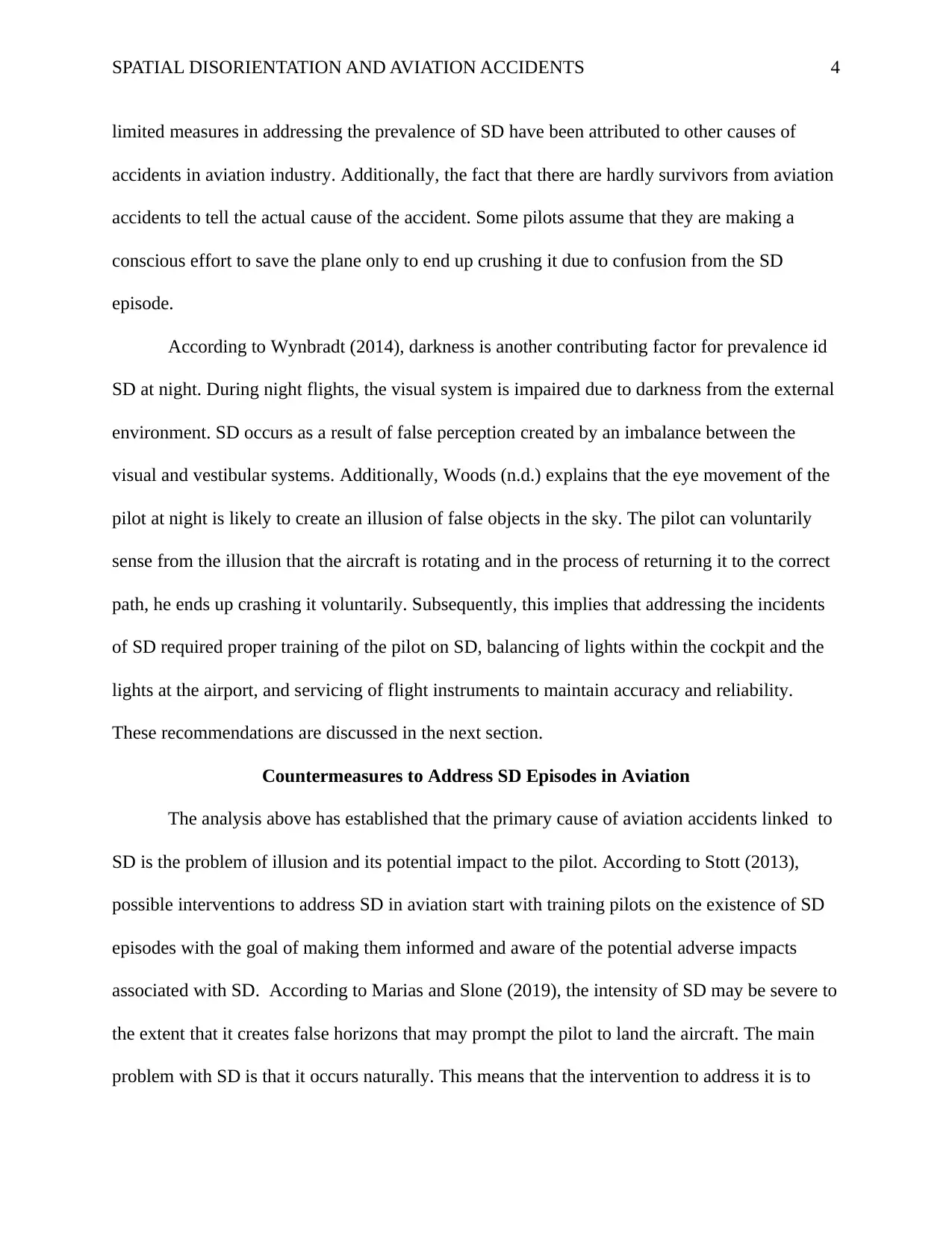
SPATIAL DISORIENTATION AND AVIATION ACCIDENTS 4
limited measures in addressing the prevalence of SD have been attributed to other causes of
accidents in aviation industry. Additionally, the fact that there are hardly survivors from aviation
accidents to tell the actual cause of the accident. Some pilots assume that they are making a
conscious effort to save the plane only to end up crushing it due to confusion from the SD
episode.
According to Wynbradt (2014), darkness is another contributing factor for prevalence id
SD at night. During night flights, the visual system is impaired due to darkness from the external
environment. SD occurs as a result of false perception created by an imbalance between the
visual and vestibular systems. Additionally, Woods (n.d.) explains that the eye movement of the
pilot at night is likely to create an illusion of false objects in the sky. The pilot can voluntarily
sense from the illusion that the aircraft is rotating and in the process of returning it to the correct
path, he ends up crashing it voluntarily. Subsequently, this implies that addressing the incidents
of SD required proper training of the pilot on SD, balancing of lights within the cockpit and the
lights at the airport, and servicing of flight instruments to maintain accuracy and reliability.
These recommendations are discussed in the next section.
Countermeasures to Address SD Episodes in Aviation
The analysis above has established that the primary cause of aviation accidents linked to
SD is the problem of illusion and its potential impact to the pilot. According to Stott (2013),
possible interventions to address SD in aviation start with training pilots on the existence of SD
episodes with the goal of making them informed and aware of the potential adverse impacts
associated with SD. According to Marias and Slone (2019), the intensity of SD may be severe to
the extent that it creates false horizons that may prompt the pilot to land the aircraft. The main
problem with SD is that it occurs naturally. This means that the intervention to address it is to
limited measures in addressing the prevalence of SD have been attributed to other causes of
accidents in aviation industry. Additionally, the fact that there are hardly survivors from aviation
accidents to tell the actual cause of the accident. Some pilots assume that they are making a
conscious effort to save the plane only to end up crushing it due to confusion from the SD
episode.
According to Wynbradt (2014), darkness is another contributing factor for prevalence id
SD at night. During night flights, the visual system is impaired due to darkness from the external
environment. SD occurs as a result of false perception created by an imbalance between the
visual and vestibular systems. Additionally, Woods (n.d.) explains that the eye movement of the
pilot at night is likely to create an illusion of false objects in the sky. The pilot can voluntarily
sense from the illusion that the aircraft is rotating and in the process of returning it to the correct
path, he ends up crashing it voluntarily. Subsequently, this implies that addressing the incidents
of SD required proper training of the pilot on SD, balancing of lights within the cockpit and the
lights at the airport, and servicing of flight instruments to maintain accuracy and reliability.
These recommendations are discussed in the next section.
Countermeasures to Address SD Episodes in Aviation
The analysis above has established that the primary cause of aviation accidents linked to
SD is the problem of illusion and its potential impact to the pilot. According to Stott (2013),
possible interventions to address SD in aviation start with training pilots on the existence of SD
episodes with the goal of making them informed and aware of the potential adverse impacts
associated with SD. According to Marias and Slone (2019), the intensity of SD may be severe to
the extent that it creates false horizons that may prompt the pilot to land the aircraft. The main
problem with SD is that it occurs naturally. This means that the intervention to address it is to
Paraphrase This Document
Need a fresh take? Get an instant paraphrase of this document with our AI Paraphraser
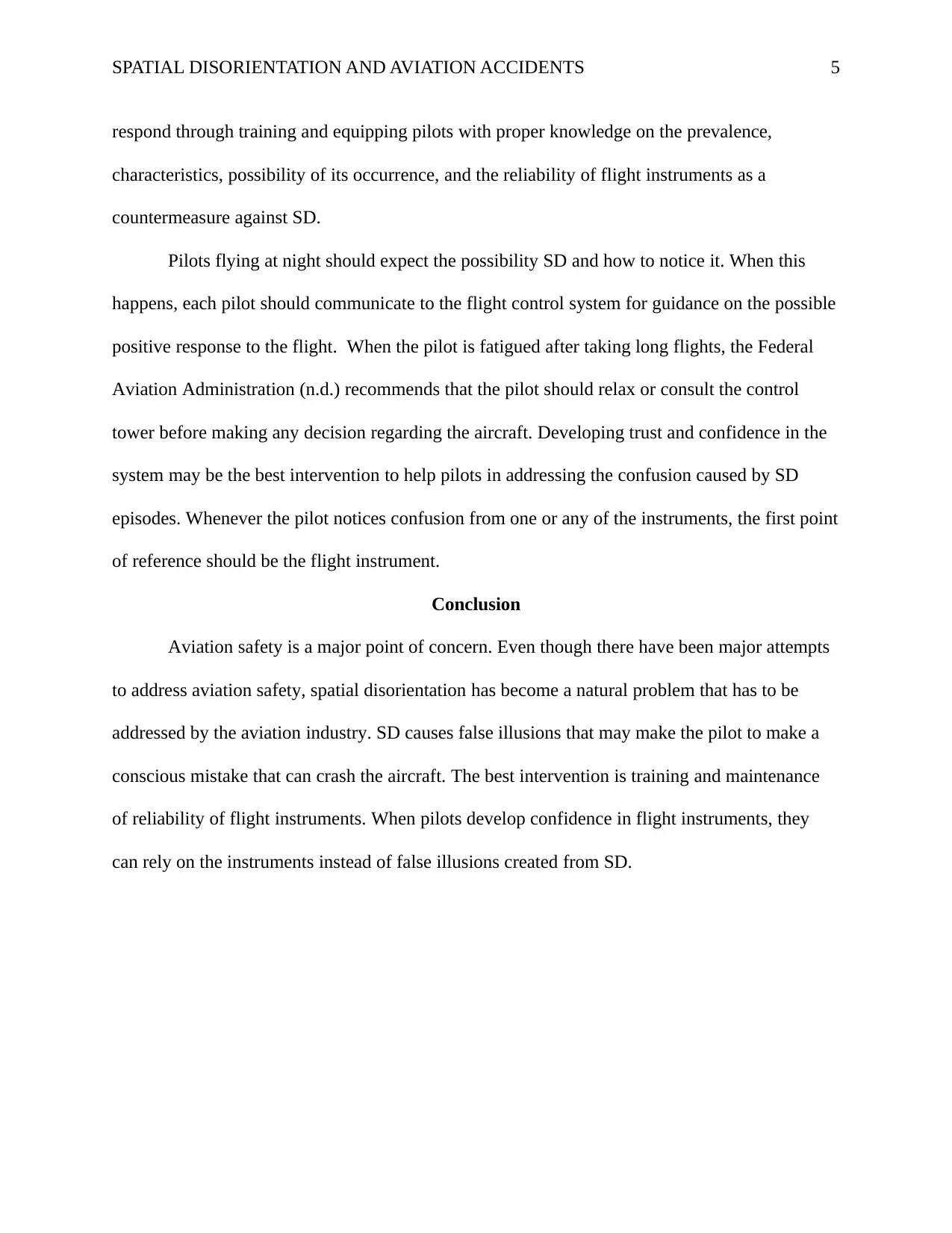
SPATIAL DISORIENTATION AND AVIATION ACCIDENTS 5
respond through training and equipping pilots with proper knowledge on the prevalence,
characteristics, possibility of its occurrence, and the reliability of flight instruments as a
countermeasure against SD.
Pilots flying at night should expect the possibility SD and how to notice it. When this
happens, each pilot should communicate to the flight control system for guidance on the possible
positive response to the flight. When the pilot is fatigued after taking long flights, the Federal
Aviation Administration (n.d.) recommends that the pilot should relax or consult the control
tower before making any decision regarding the aircraft. Developing trust and confidence in the
system may be the best intervention to help pilots in addressing the confusion caused by SD
episodes. Whenever the pilot notices confusion from one or any of the instruments, the first point
of reference should be the flight instrument.
Conclusion
Aviation safety is a major point of concern. Even though there have been major attempts
to address aviation safety, spatial disorientation has become a natural problem that has to be
addressed by the aviation industry. SD causes false illusions that may make the pilot to make a
conscious mistake that can crash the aircraft. The best intervention is training and maintenance
of reliability of flight instruments. When pilots develop confidence in flight instruments, they
can rely on the instruments instead of false illusions created from SD.
respond through training and equipping pilots with proper knowledge on the prevalence,
characteristics, possibility of its occurrence, and the reliability of flight instruments as a
countermeasure against SD.
Pilots flying at night should expect the possibility SD and how to notice it. When this
happens, each pilot should communicate to the flight control system for guidance on the possible
positive response to the flight. When the pilot is fatigued after taking long flights, the Federal
Aviation Administration (n.d.) recommends that the pilot should relax or consult the control
tower before making any decision regarding the aircraft. Developing trust and confidence in the
system may be the best intervention to help pilots in addressing the confusion caused by SD
episodes. Whenever the pilot notices confusion from one or any of the instruments, the first point
of reference should be the flight instrument.
Conclusion
Aviation safety is a major point of concern. Even though there have been major attempts
to address aviation safety, spatial disorientation has become a natural problem that has to be
addressed by the aviation industry. SD causes false illusions that may make the pilot to make a
conscious mistake that can crash the aircraft. The best intervention is training and maintenance
of reliability of flight instruments. When pilots develop confidence in flight instruments, they
can rely on the instruments instead of false illusions created from SD.
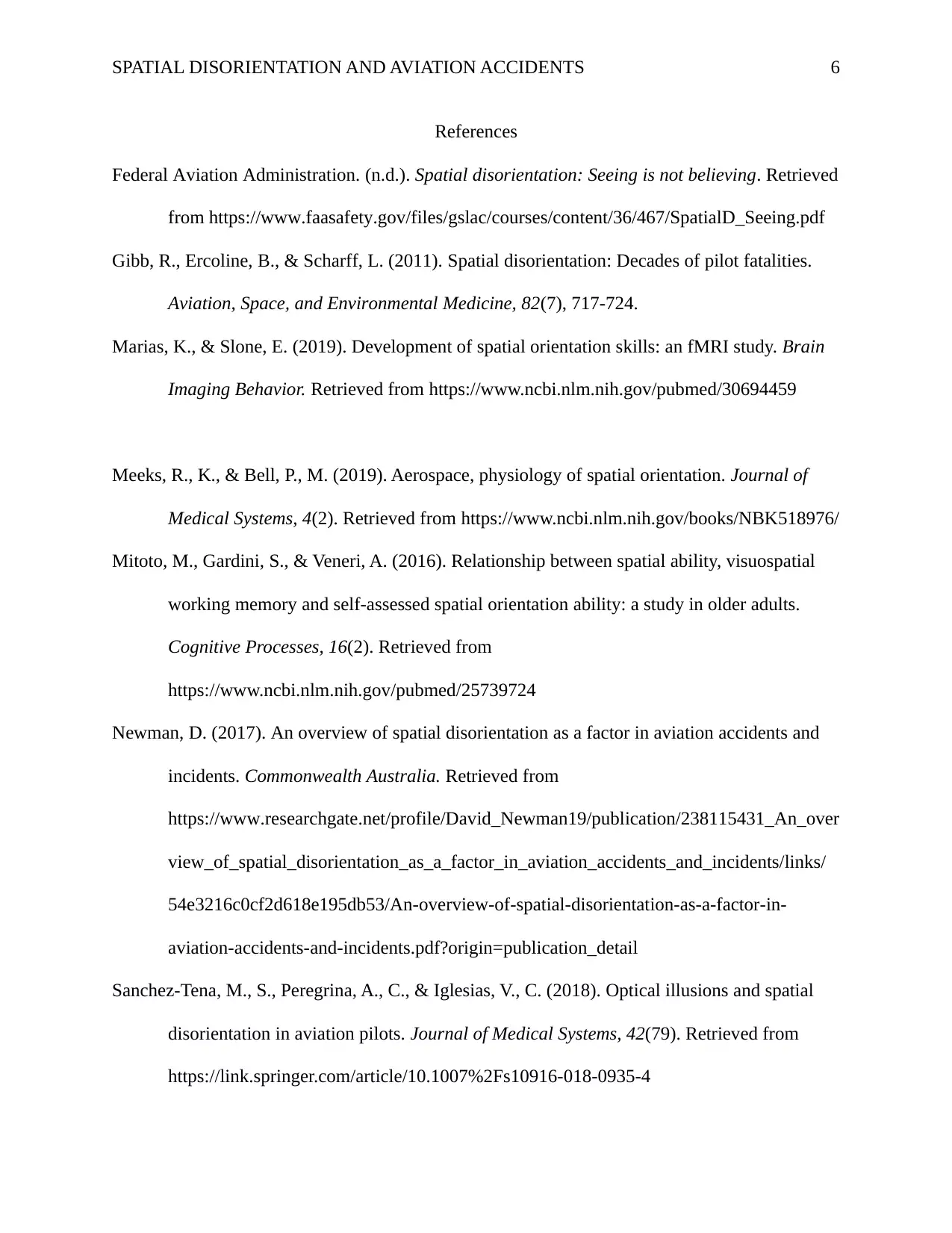
SPATIAL DISORIENTATION AND AVIATION ACCIDENTS 6
References
Federal Aviation Administration. (n.d.). Spatial disorientation: Seeing is not believing. Retrieved
from https://www.faasafety.gov/files/gslac/courses/content/36/467/SpatialD_Seeing.pdf
Gibb, R., Ercoline, B., & Scharff, L. (2011). Spatial disorientation: Decades of pilot fatalities.
Aviation, Space, and Environmental Medicine, 82(7), 717-724.
Marias, K., & Slone, E. (2019). Development of spatial orientation skills: an fMRI study. Brain
Imaging Behavior. Retrieved from https://www.ncbi.nlm.nih.gov/pubmed/30694459
Meeks, R., K., & Bell, P., M. (2019). Aerospace, physiology of spatial orientation. Journal of
Medical Systems, 4(2). Retrieved from https://www.ncbi.nlm.nih.gov/books/NBK518976/
Mitoto, M., Gardini, S., & Veneri, A. (2016). Relationship between spatial ability, visuospatial
working memory and self-assessed spatial orientation ability: a study in older adults.
Cognitive Processes, 16(2). Retrieved from
https://www.ncbi.nlm.nih.gov/pubmed/25739724
Newman, D. (2017). An overview of spatial disorientation as a factor in aviation accidents and
incidents. Commonwealth Australia. Retrieved from
https://www.researchgate.net/profile/David_Newman19/publication/238115431_An_over
view_of_spatial_disorientation_as_a_factor_in_aviation_accidents_and_incidents/links/
54e3216c0cf2d618e195db53/An-overview-of-spatial-disorientation-as-a-factor-in-
aviation-accidents-and-incidents.pdf?origin=publication_detail
Sanchez-Tena, M., S., Peregrina, A., C., & Iglesias, V., C. (2018). Optical illusions and spatial
disorientation in aviation pilots. Journal of Medical Systems, 42(79). Retrieved from
https://link.springer.com/article/10.1007%2Fs10916-018-0935-4
References
Federal Aviation Administration. (n.d.). Spatial disorientation: Seeing is not believing. Retrieved
from https://www.faasafety.gov/files/gslac/courses/content/36/467/SpatialD_Seeing.pdf
Gibb, R., Ercoline, B., & Scharff, L. (2011). Spatial disorientation: Decades of pilot fatalities.
Aviation, Space, and Environmental Medicine, 82(7), 717-724.
Marias, K., & Slone, E. (2019). Development of spatial orientation skills: an fMRI study. Brain
Imaging Behavior. Retrieved from https://www.ncbi.nlm.nih.gov/pubmed/30694459
Meeks, R., K., & Bell, P., M. (2019). Aerospace, physiology of spatial orientation. Journal of
Medical Systems, 4(2). Retrieved from https://www.ncbi.nlm.nih.gov/books/NBK518976/
Mitoto, M., Gardini, S., & Veneri, A. (2016). Relationship between spatial ability, visuospatial
working memory and self-assessed spatial orientation ability: a study in older adults.
Cognitive Processes, 16(2). Retrieved from
https://www.ncbi.nlm.nih.gov/pubmed/25739724
Newman, D. (2017). An overview of spatial disorientation as a factor in aviation accidents and
incidents. Commonwealth Australia. Retrieved from
https://www.researchgate.net/profile/David_Newman19/publication/238115431_An_over
view_of_spatial_disorientation_as_a_factor_in_aviation_accidents_and_incidents/links/
54e3216c0cf2d618e195db53/An-overview-of-spatial-disorientation-as-a-factor-in-
aviation-accidents-and-incidents.pdf?origin=publication_detail
Sanchez-Tena, M., S., Peregrina, A., C., & Iglesias, V., C. (2018). Optical illusions and spatial
disorientation in aviation pilots. Journal of Medical Systems, 42(79). Retrieved from
https://link.springer.com/article/10.1007%2Fs10916-018-0935-4
⊘ This is a preview!⊘
Do you want full access?
Subscribe today to unlock all pages.

Trusted by 1+ million students worldwide
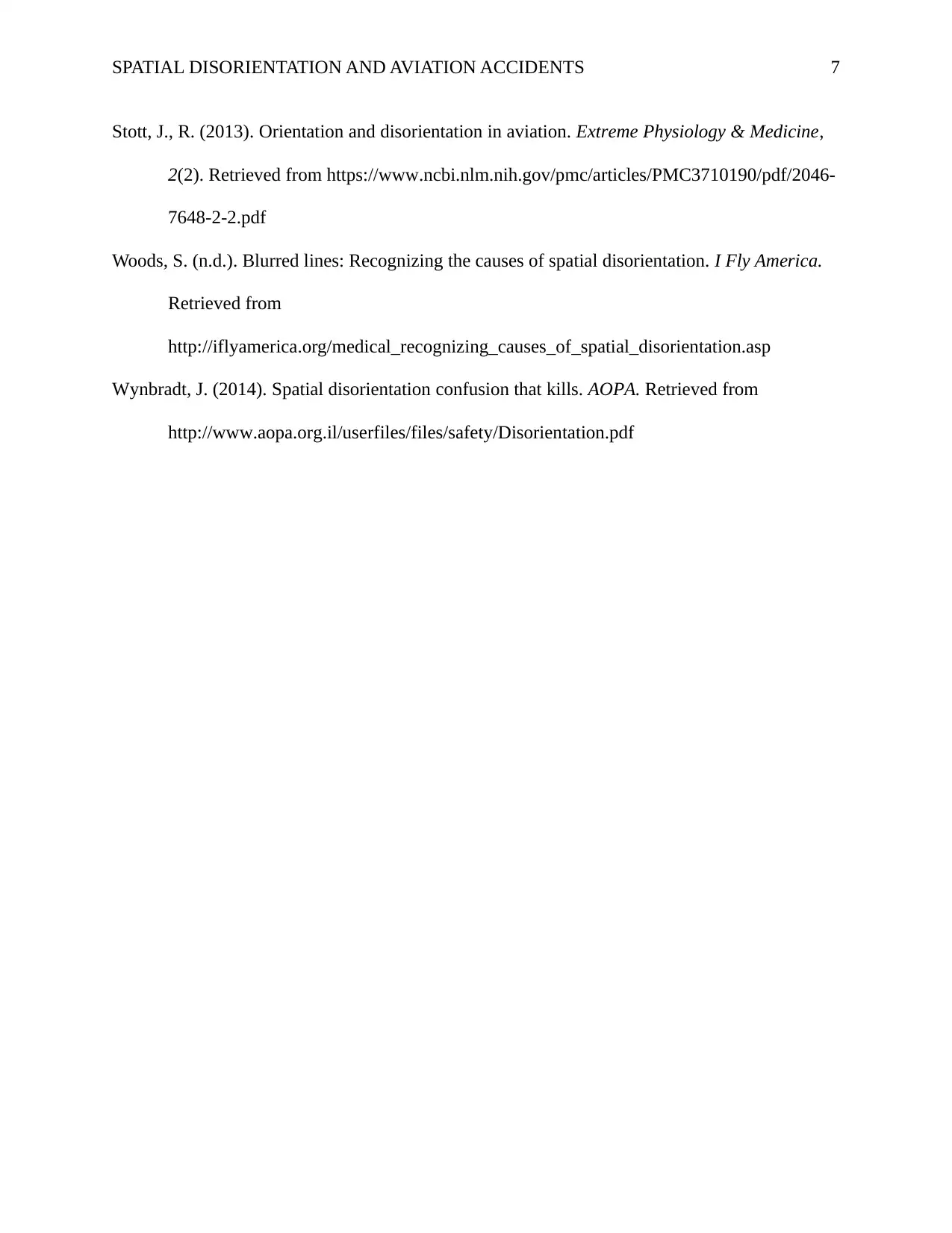
SPATIAL DISORIENTATION AND AVIATION ACCIDENTS 7
Stott, J., R. (2013). Orientation and disorientation in aviation. Extreme Physiology & Medicine,
2(2). Retrieved from https://www.ncbi.nlm.nih.gov/pmc/articles/PMC3710190/pdf/2046-
7648-2-2.pdf
Woods, S. (n.d.). Blurred lines: Recognizing the causes of spatial disorientation. I Fly America.
Retrieved from
http://iflyamerica.org/medical_recognizing_causes_of_spatial_disorientation.asp
Wynbradt, J. (2014). Spatial disorientation confusion that kills. AOPA. Retrieved from
http://www.aopa.org.il/userfiles/files/safety/Disorientation.pdf
Stott, J., R. (2013). Orientation and disorientation in aviation. Extreme Physiology & Medicine,
2(2). Retrieved from https://www.ncbi.nlm.nih.gov/pmc/articles/PMC3710190/pdf/2046-
7648-2-2.pdf
Woods, S. (n.d.). Blurred lines: Recognizing the causes of spatial disorientation. I Fly America.
Retrieved from
http://iflyamerica.org/medical_recognizing_causes_of_spatial_disorientation.asp
Wynbradt, J. (2014). Spatial disorientation confusion that kills. AOPA. Retrieved from
http://www.aopa.org.il/userfiles/files/safety/Disorientation.pdf
1 out of 7
Your All-in-One AI-Powered Toolkit for Academic Success.
+13062052269
info@desklib.com
Available 24*7 on WhatsApp / Email
![[object Object]](/_next/static/media/star-bottom.7253800d.svg)
Unlock your academic potential
Copyright © 2020–2025 A2Z Services. All Rights Reserved. Developed and managed by ZUCOL.
